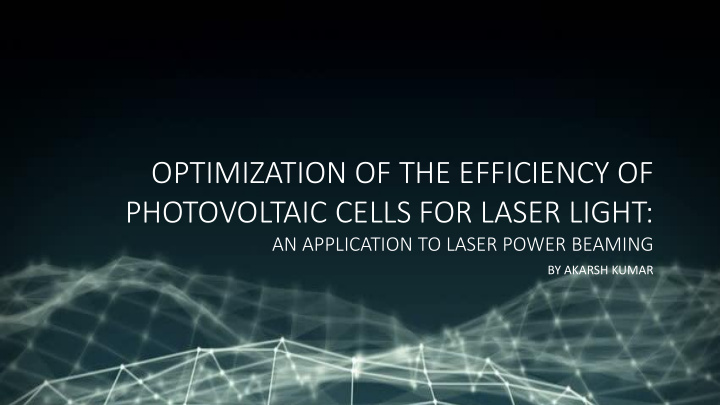



OPTIMIZATION OF THE EFFICIENCY OF PHOTOVOLTAIC CELLS FOR LASER LIGHT: AN APPLICATION TO LASER POWER BEAMING BY AKARSH KUMAR
BACKGROUND Laser power beaming is transferring energy with lasers and PV cells NASA and LaserMotive made prototypes of drones that can stay in flight indefinitely Not used widely because of relative inefficiency If laser power beaming is optimized, the technology will have applications in transmitting energy through fiber optics cables (power over fiber)
PURPOSE This project looks into theoretically optimizing PV cells for laser light Find the theoretical upper limit of the efficiency of laser power beaming See if it is a viable option for energy transfer Can start new generation of wireless energy transfer
DISCUSSION Shockley and Queisser’s methods were used to optimize a PV cell for the sunlight spectrum (simple blackbody) Found ultimate efficiency function based on the temperature of the sun and the energy of the bandgap This project replaced the sunlight spectrum with a laser spectrum: 𝑏 𝜌 𝑇 𝜉 = 𝜉 − 𝜉 0 2 + 𝑏 2
THEORETICAL WORK Photon density, 𝑅 𝑡,0 , in spectrum (Eqn 2): Total output power if each photon above/equal to the band gap gives the PV cell the energy 𝑅 𝑡,0 = 𝑇(𝜉) 𝑏 equal to the band gap, ℎ𝜉 , and 𝐵 is the area of ℎ𝜉 = 𝜌ℎ𝜉[(𝜉 − 𝜉 0 ) 2 +𝑏 2 ] the cell (Eqn 5): Number of photons, 𝑅 𝑡 , with frequency above the band gap 𝑃𝑣𝑢𝑞𝑣𝑢 𝑞𝑝𝑥𝑓𝑠 = ℎ𝜉 𝐵𝑅 𝑡 frequency, 𝜉 (Eqn 3): Power per unit area of the entire laser ∞ ∞ 𝑏 spectrum is normalized (Eqn 6): 𝑅 𝑡 = 𝑅 𝑡,0 𝑒𝜉 = 𝜌ℎ𝜉[(𝜉 − 𝜉 0 ) 2 +𝑏 2 ] 𝑒𝜉 𝜉 𝑤 ∞ 𝑄 𝑡 = 𝑇 𝜉 𝑒𝜉 = 1 𝑅 𝑡 evaluated as function of band gap frequency (Eqn 4): 0 𝑅 𝑡 𝑤 Power over area of cell (Eqn 7): 𝜌𝜉 0 + 𝑏 ln (𝑤 − 𝑤 0 ) 2 +𝑏 2 + 2𝜉 0 tan −1 (𝜉 0 − 𝜉 1 𝐽𝑜𝑞𝑣𝑢 𝑞𝑝𝑥𝑓𝑠 = 𝐵𝑄 = ) 𝑡 2𝜌ℎ 𝑏 2 + 𝜉 02 𝜉 2 𝑏
THEORETICAL WORK CONTINUED Definition and evaluation of the efficiency function of the cell (Eqn 8, 9): 𝑗𝑜𝑞𝑣𝑢 𝑞𝑝𝑥𝑓𝑠 = ℎ𝜉 𝐵𝑅 𝑡 𝜃 = 𝑝𝑣𝑢𝑞𝑣𝑢 𝑞𝑝𝑥𝑓𝑠 𝐵𝑄 𝑡 𝜉 𝜃 𝜉 0 , 𝜉 = 2𝜌 𝑏 2 +𝜉 02 𝜌𝜉 0 +
LASER LINEWIDTH Following graphs of the ultimate efficiency have drastically different linewidths Linewidth of 1 GHz Almost no difference in efficiency graphs. Used a standard above average 1 GHz for rest of calculation Linewidth of 1 THz
RESULTS The ultimate efficiency function ( Eqn 9 ) used to create color map ( Figure 6 ) Represents efficiencies of laser energies and band gap energies using a linewidth of 1 GHz Directly matches the ultimate efficiency graphs of Figure 4 and 5 Gradual increase in efficiency as the band gap energy approaches the laser energy then suddenly dips to near zero when band gap energy exceeds the laser energy (going from top right to bottom left)
RESULTS CONTINUED Laser PV Cell Efficiency I (0.94 eV) Cu 2 SnS 3 (0.91 eV) 96.51% InGaAsP (1.24 eV) BAs (1.14 eV) 91.95% Table 1 shows various laser - PV cell Ruby (1.79 eV) CdSe (1.74 eV) 97.44% efficiencies based on the ultimate Xe+ (2.48 eV) ZnTe (2.25 eV) 90.74% efficiency equation derived Xe+ (2.48 eV) CdS (2.42 eV) 97.59% Theoretical efficiencies approach higher Ar+ (2.73 eV) ZnSe (2.7 eV) 98.99% than 90% XeF-Excimer (3.51 eV) TiO 2 (3.2 eV) 91.11% These combinations are optimal for laser XeF-Excimer (3.51 eV) ZnO (3.37 eV) 95.95% power beaming XeF-Excimer (3.51 eV) CuCl (3.4 eV) 96.80% XeF-Excimer (3.51 eV) GaN (3.44 eV) 97.94% N (3.68 eV) ZnS-cubic (3.54 eV) 96.25% N (3.68 eV) NiO (3.6 eV) 97.88% XeCl-Excimer (4.03 eV) ZnS-hex (3.91 eV) 97.13% ArF-Excimer (6.42 eV) AlN (6.28 eV) 97.76%
CONCLUSION AND FUTURE RESEARCH Laser power beaming is a viable option for energy transfer when using the right laser and PV cell Future researchers should theoretically model efficiency degrading factors The lack of proper laser light - cell incidence The reflection of light off the surface of the cell The loss in energy through the blackbody of the cell Recombination of the holes and electrons Electrical losses within the cell and within the circuit Future researchers should do real life tests to show practical efficiencies reached
OPTIMIZATION OF THE EFFICIENCY OF PHOTOVOLTAIC CELLS FOR LASER LIGHT: AN APPLICATION TO LASER POWER BEAMING BY AKARSH KUMAR
Recommend
More recommend